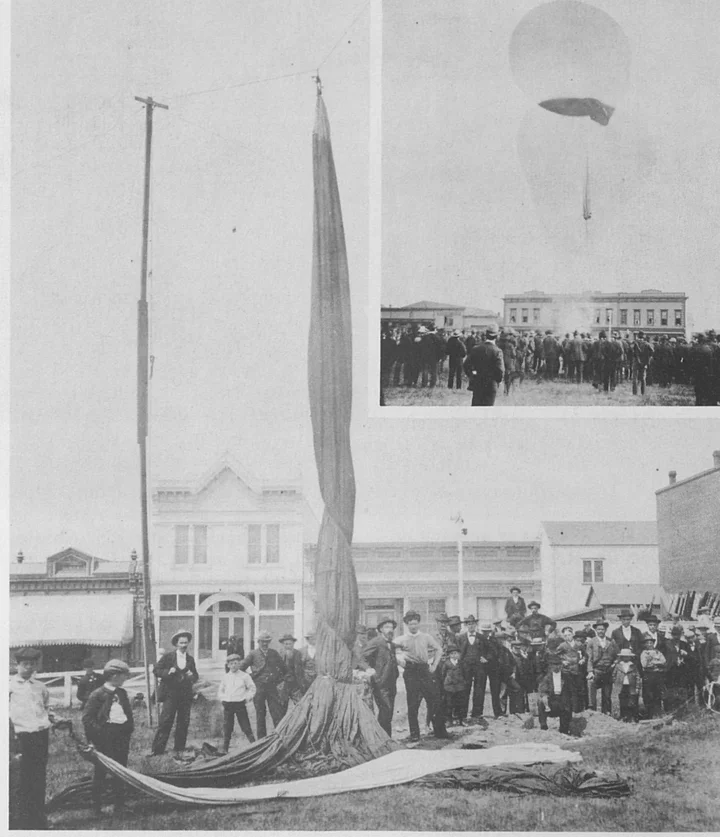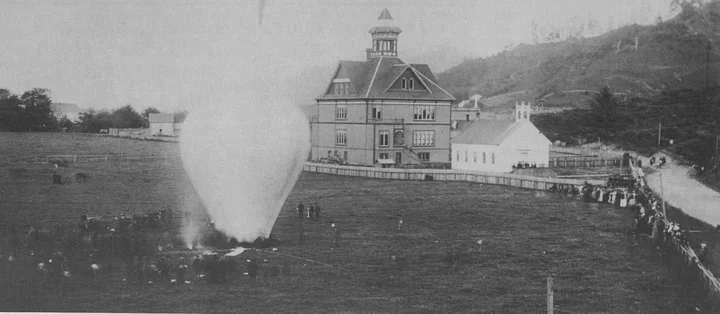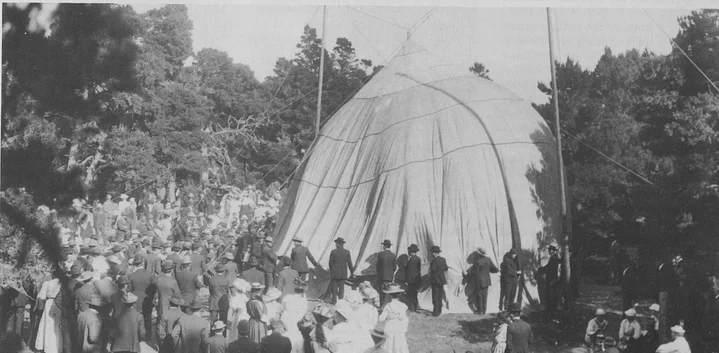Photos above and above right show preparations for an ascension on the Arcata Plaza. A crudely lettered caption noted that after the aeronauts had taken off they had landed in a bunch of trees and were killed. Presumably the writer was speaking of the same fatal ascent which had occurred in Eureka. It also suggests, however, that these photos may picture the very same balloonists shortly before their tragic attempt in Eureka. Photos by A. W. Ericson, c. 1897 via the Humboldt Historian.
Horse racing has been labeled the “King of Sports” because of its great appeal as a spectator event. Hot air ballooning, however, was very nearly as popular near the turn of the century and had several interesting advantages as well.
Volunteers were often asked to assist with laying out the balloonist’s gear at the launch site, helping to erect a guy-line to hold the balloon in an upright position, gathering firewood, and the like.
Especially exciting were the events of launch day. The fire had to be built just so, and the limp bag manipulated to capture as much hot air as possible. Soon the restraining ropes began to take on a life of their own and the assembled crowd began to buzz with anticipation.
The aeronauts were young men of daring, often with an exaggerated swagger in their walk. No matter how nervous they might feel inside, it was important to show no fear as the moment of ascent approached. In the final seconds everything was checked and rechecked. Was the wind too strong? Were those nearby buildings and trees too close? Enough ballast? Too much? Now!
If they were successful, the rewards were great — instant fame and a chance to see faraway places. After a few years on the circuit the balloonists could sport the title “professor” and enter the celebrity limelight. Many, however, had dreadful scars or bad limps attesting to aborted flights and hard landings.
Getting a balloon ready for flight near the Ferndale Elementary School in 1892. Photo by William Wax, via the Humboldt Historian.
Ballooning came to Humboldt County in the 1870s and continued as a popular spectator event, especially around the 4th of July, into the early part of this century. The Arcata Plaza was a favorite site, as was Eureka’s Sequoia Park. In Ferndale the most popular place for balloon launches was the playground of the Ferndale Elementary School.
When the balloonist positioned himself in the sling below the giant bag he never knew exactly what would happen. The balloon could rise straight up, or a sudden wind could send it swiftly towards disaster. The following account, from the local “Daily Standard,” July 6, 1897, clearly attests to the dangers of the balloonist’s profession:
A HORRIBLE ACCIDENT:
Yesterday afternoon at 1:30 o’clock several hundred people witnessed a very distressing accident. Prof. Weston and his helpers had announced that on account of the wind an ascension would be made from a sheltered point on Twelfth street between the alder trees. The people had gathered there to witness the ascension, and as announced the balloon men were on hand and proceeded with their work.
Finally the balloon was inftated, and the order was given to let go. Up it shot with Prof. Weston on the trapeze and also with one of the helpers caught in the ropes. The helper was H. Tapscott, whose duty it was to lie on his back in the balloon and watch the flame which generates the hot air. He thought he was clear of the ropes, but he had evidently been lying on one. He rose about twenty-five feet when he disentangled himself and fell violently to the ground, striking his head. He sustained a concussion of the brain and a compound fracture of the right thigh.
The balloon had not gone up far enough to clear the trees when the extra weight of the helper changed its course and it threw the aeronaut against the trees, and he too suffered a frightful fall, sustaining concussion of the brain, a compound fracture of the right thigh and several broken ribs. The sight was horrifying and weakened the strongest men in the assemblage.
Several physicians who were nearby rushed to the assistance of the unfortunate men who were removed to the Humboldt General Hospital where everything possible was done to alleviate their sufferings, but the general verdict of the physicians was that neither would survive. The verdict was all too true, for at ten minutes to five this morning Mr. Tapscott died, and at five o’clock, just ten minutes later, the aeronaut passed away.
Full particulars of the past of these men have not been learned as yet, but it is claimed that Weston was bom on March 2, 1871, in Olney, Oregon, and has been in the aeronaut business for several years with considerable success. It is said that he has a mother and sister in San Francisco. His unfortunate companion was about thirty years of age and was a resident of Aberdeen, Washington.
Since the above was put in type it is learned that Weston’s real name is George Weston Daggett. Among his effects were found a number of photographs of ascensions he has made in other places. It is the general belief that had the helper not become entangled in the ropes yesterday the ascension would have been very successful. The balloon was not sufficiently strong to carry both men up above the trees, but with only the weight of one man to lift, the trees would have been cleared and all would have been well.
Crowd watches preparations for balloon ascent. Note poles with guy ropes used to hold the balloon above the inflating wood-fired blaze. This event is thought to have taken place at New Era Park in about 1907. Photo: R.J.Baker, via the Humboldt Historian.
###
The story above was originally printed in the May-June 1986 issue of the Humboldt Historian, a journal of the Humboldt County Historical Society. It is reprinted here with permission. The Humboldt County Historical Society is a nonprofit organization devoted to archiving, preserving and sharing Humboldt County’s rich history. You can become a member and receive a year’s worth of new issues of The Humboldt Historian at this link.



CLICK TO MANAGE